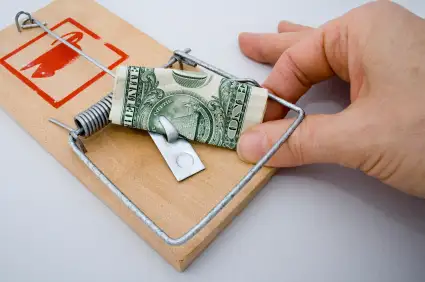
On my last trip to Europe, I didn’t bring my usual $200 cash reserve. With just a few bucks in my wallet, I landed in Madrid, relying entirely on two ATM cards and no cash safety net. It turned out OK. At the airport, I withdrew some euros from an ATM machine, and tucked the bills into my money belt. After decades of traveling to Europe, I have found that the cheapest, safest way to go is to pay with cash for most items, and withdraw money as I zip from one place to the next. The reason? To cut down on fees and fraud.
I realize fees aren’t an exciting topic…at least not until you get your bank statement after your trip. Over the last few years, banks have dramatically increased the fees they charge for overseas transactions involving credit and debit cards. While these fees are legal—and some are even understandable—many are contrived simply to wring a few more dollars out of tourists. But by traveling smart and doing a little research up front, you can cut back on these extra expenses.
There are different types of fees. Banks may levy a flat $2 to $5 transaction fee each time you use your ATM card, plus an additional 1 to 3 percent for currency conversion. The machine you use might charge you, too. Visa and MasterCard impose a 1 percent fee on international transactions, and the issuing banks may tack on an additional currency conversion or foreign ¬transaction fee of 1 to 2 percent.
Before your trip, call your bank or credit-card company to find out what you’ll pay when using their card overseas. If they charge exorbitant fees, either ditch them, or consider getting a card just for your trip. Bankrate has a helpful comparison chart of major credit cards and their fees (www.bankrate.com). Most credit unions have low-to-no international fees. Capital One has a good reputation for no-fee international transactions on both its credit cards and its ATM-accessible money market accounts (www.capitalone.com).
If your bank charges a flat fee per transaction, cut down on ATM visits in Europe by withdrawing larger amounts. If the machine refuses your request, try again and select a smaller amount (some cash machines limit the amount you can withdraw—don’t take it personally). If that doesn’t work, try a different machine. Be sure to stow your cash safely in a money belt; it’s a pouch on a belt worn around your waist tucked under your clothes.
Because businesses must also pay fees to credit-card companies, some merchants and hoteliers—particularly in southern Europe—may give you a better deal if you offer to pay cash with their currency (which also allows them to avoid reporting—and being taxed on—all of their income).
When you’re paying for hotels, meals, or that Prada bag, some merchants will ask if you want to be charged in dollars (a service called dynamic currency conversion, or DCC). Politely refuse. Usually the dollar price is based on a lousy exchange rate, plus your credit-card issuer may still impose a foreign transaction fee. The result: You could pay up to a 6 percent premium for the “convenience.”
Anytime you use a debit or credit card, beware of scammers. When entering your PIN, cover the keypad so that thieves can’t see what you’re typing. Shoulder surfing is a common problem. Also, use your credit card sparingly. Restaurant servers and shop clerks might try to steal your information, sometimes by swiping your card through a special machine that reads it (a technique called “skimming”) or by surreptitiously snapping a photo of it with their cell phone.
In order to protect against fraud, some European countries, including Britain, France, the Netherlands, and those in Scandinavia, have started using chip and PIN technology for their credit and debit cards. These smartcards come with an embedded microchip, and cardholders must enter a personal identification number (PIN) instead of signing a receipt. Though most merchants should be able to run transactions without a PIN, some might insist on one. For this reason, it’s smart to know the PIN for your credit card; ask your credit-card company before you go.
When traveling, I only use my credit card for booking hotel reservations by phone, making major purchases (such as car rentals and plane tickets), and paying for things near the end of my trip to avoid another visit to the ATM. A dependence on plastic reshapes the Europe you experience. Pedro’s Pension, the friendly guide at the cathedral, and most merchants in the market don’t take credit cards. Going through the back door requires cold, hard local cash.
Rick Steves (www.ricksteves.com) writes European travel guidebooks and hosts travel shows on public television and public radio. Email him at rick@ricksteves.com and follow his blog on Facebook.
We hand-pick everything we recommend and select items through testing and reviews. Some products are sent to us free of charge with no incentive to offer a favorable review. We offer our unbiased opinions and do not accept compensation to review products. All items are in stock and prices are accurate at the time of publication. If you buy something through our links, we may earn a commission.
Related
Top Fares From Columbus, OH
Today's Top Travel Deals
Brought to you by ShermansTravel
Shop and Save with Country Inns...
Patricia Magaña
 Hotel & Lodging Deals
Hotel & Lodging Deals
$229 -- Chicago: Discounted Rates and...
Francesca Miele
 Hotel & Lodging Deals
$229+
Hotel & Lodging Deals
$229+
$188 -- Honolulu: Save on Oceanview...
Abigail Lamay
 Hotel & Lodging Deals
$188+
Hotel & Lodging Deals
$188+



